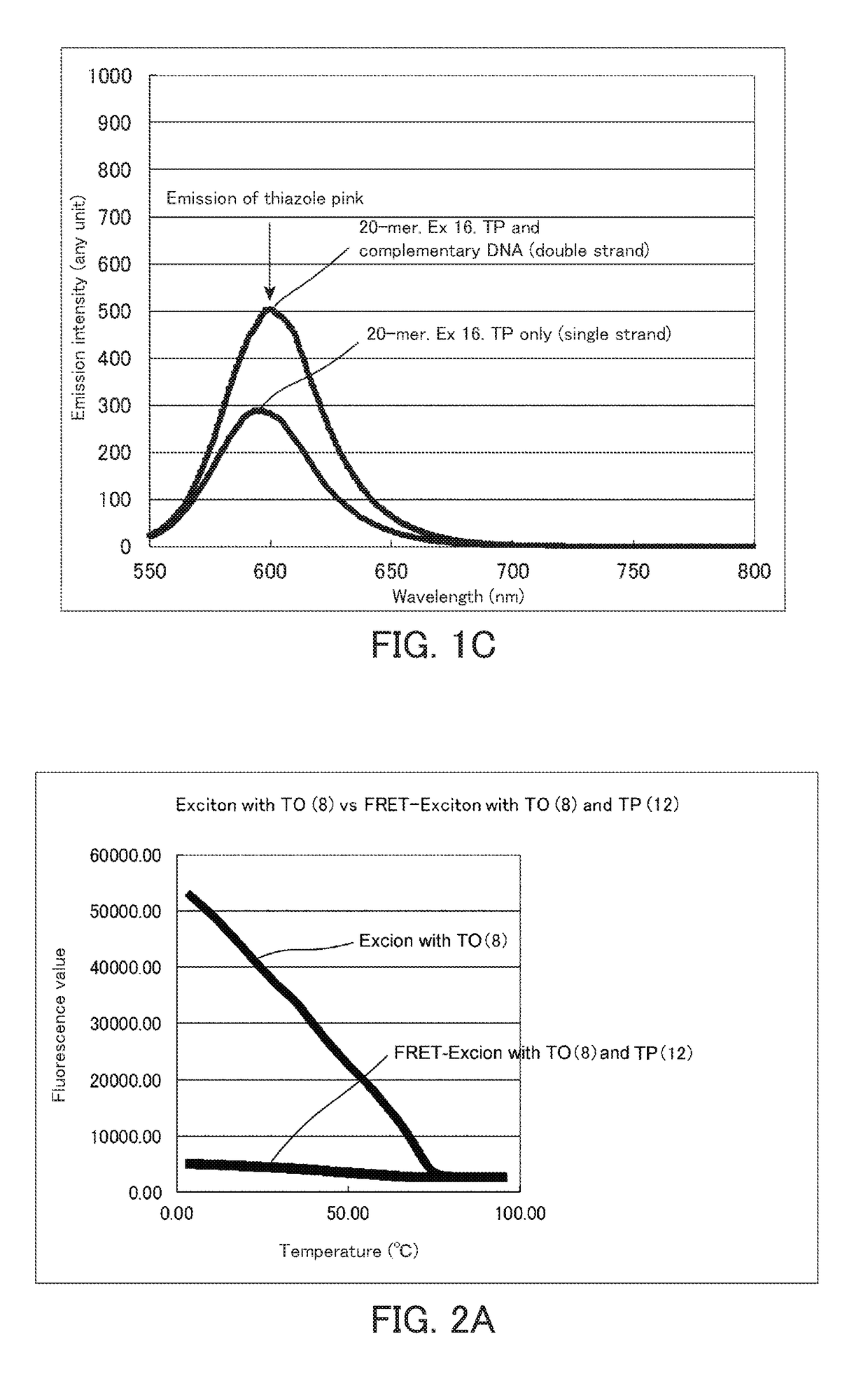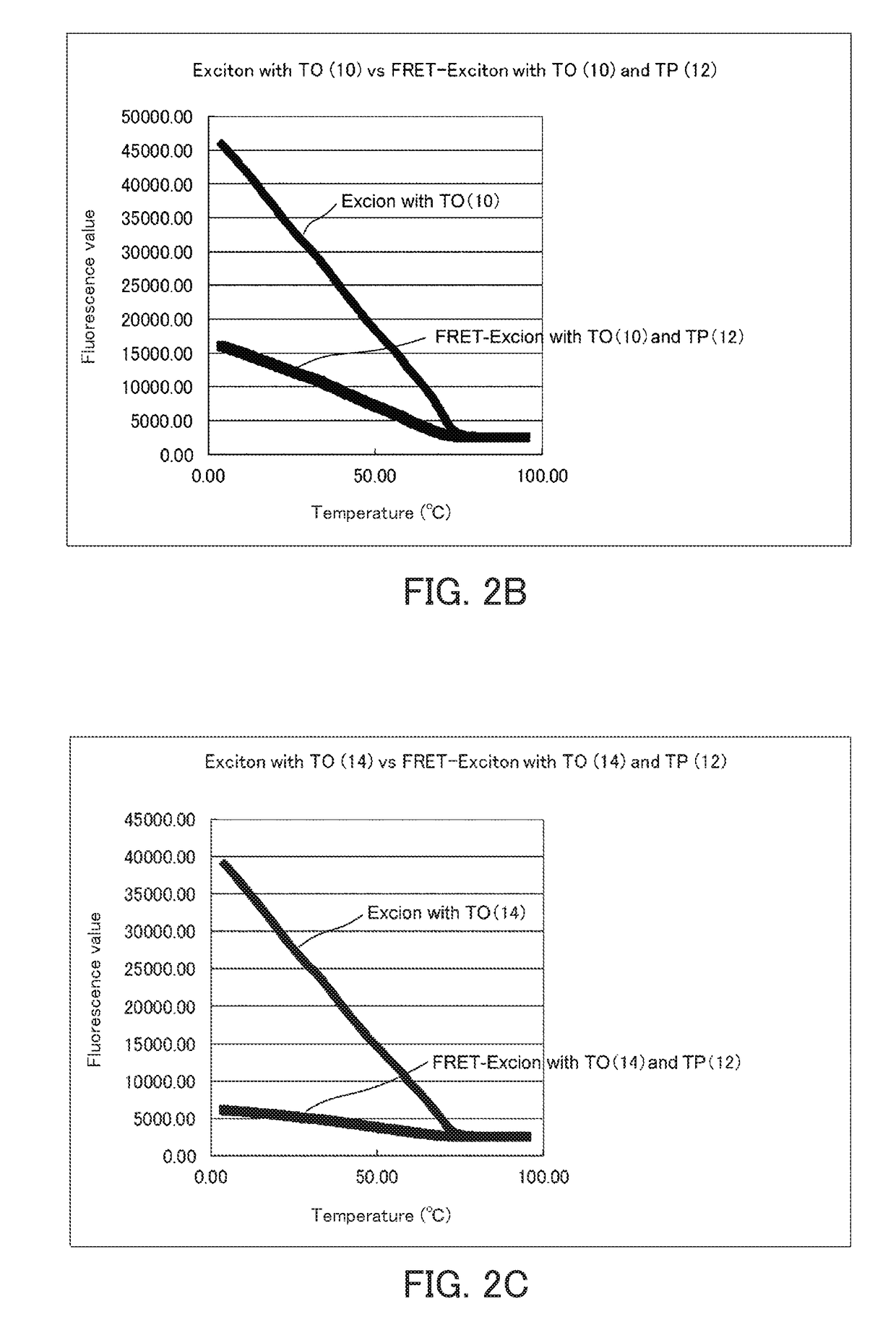Fluorescent labeled single-stranded nucleic acid and use thereof
- Summary
- Abstract
- Description
- Claims
- Application Information
AI Technical Summary
Benefits of technology
Problems solved by technology
Method used
Image
Examples
example 1
[0151]Oligo DNA strands into each of which thiazole orange (TO) and thiazole pink (TP) had been introduced as scaffolds were synthesized by an amidite method described in Patent Literature 2 (for example, see Example 2). TO was introduced by introducing NHS-Carboxy-dT into an intended position and immediately thereafter causing TO2 diamidite to react therewith and then synthesizing a sequence after the position by a conventional method. Cutting out from CPG and deprotection were carried out in 28% ammonia water at 55° C. for 4 hours. Purification was carried out by HPLC equipped with a reverse-phase (RP-18) column.
[0152]TO2 Diamide
[0153]Thereafter, a nucleic acid obtained after the purification and TP-ester were caused to react with each other in a sodium bicarbonate buffer according to the method described in Patent Literature 1 (for example, Example 6 (see (synthesis of compound into which two structures induced from thiazole orange into one molecule had been introduced)), and pur...
example 2
[0156](Spectrum Comparison Experiment Between Fluorescence Nucleic Acid Probe into which Two Fluorescent Dyes Having Exciton Effect have been Introduced and Conventional Fluorescence Probe Having Exciton Effect)
[0157]The probes were excited at an excitation wavelength (490 nm) of thiazole orange to carry out spectrum measurement. The spectrum measurement was carried out using a fluorescence measurement device (RF5300) manufactured by Shimadzu Corporation. The measurement was carried out at concentrations of each fluorescence probe and a complementary strand (SEQ ID NO: 2) of 1 μM and a temperature of 23° C. The results are shown in FIGS. 1A to 1C. FIG. 1A is a spectrum obtained in the case of using a fluorescence nucleic acid probe into which two fluorescent dyes having an exciton effect have been introduced. FIGS. 1B and 1C are spectra of a conventional fluorescence probe having an exciton effect. In the case of two fluorescent dyes having an exciton effect, the fluorescence at a w...
example 3
[0159]Melting curve analysis of the fluorescence nucleic acid probe into which two fluorescent dyes having exciton effect had been introduced was carried out using a real-time PCR device (CFX96) manufactured by BioRad. The measurement of the melting curve was carried out at concentrations of each fluorescence probe and a complementary strand of 1 μM and a volume of 25 μl. The measurement was carried out while increasing the temperature from 4° C. to 95° C. by 0.5° C. The results are shown in FIGS. 2A to 2E. The results shown in FIGS. 2A to 2E are comparison of fluorescence of thiazole orange (excitation wavelength: 495 nm). When the distance between thiazole orange and thiazole pink is appropriate, the fluorescence of thiazole orange was largely reduced by the FRET effect.
[0160]It is considered from the results in FIGS. 2A to 2E that the FRET effect is most exhibited in the fluorescence labeled single-stranded nucleic acid (DNA) used in the present example when the distance between ...
PUM
| Property | Measurement | Unit |
|---|---|---|
| Resonance energy | aaaaa | aaaaa |
| Distance | aaaaa | aaaaa |
| Wavelength | aaaaa | aaaaa |
Abstract
Description
Claims
Application Information
 Login to View More
Login to View More - R&D
- Intellectual Property
- Life Sciences
- Materials
- Tech Scout
- Unparalleled Data Quality
- Higher Quality Content
- 60% Fewer Hallucinations
Browse by: Latest US Patents, China's latest patents, Technical Efficacy Thesaurus, Application Domain, Technology Topic, Popular Technical Reports.
© 2025 PatSnap. All rights reserved.Legal|Privacy policy|Modern Slavery Act Transparency Statement|Sitemap|About US| Contact US: help@patsnap.com



